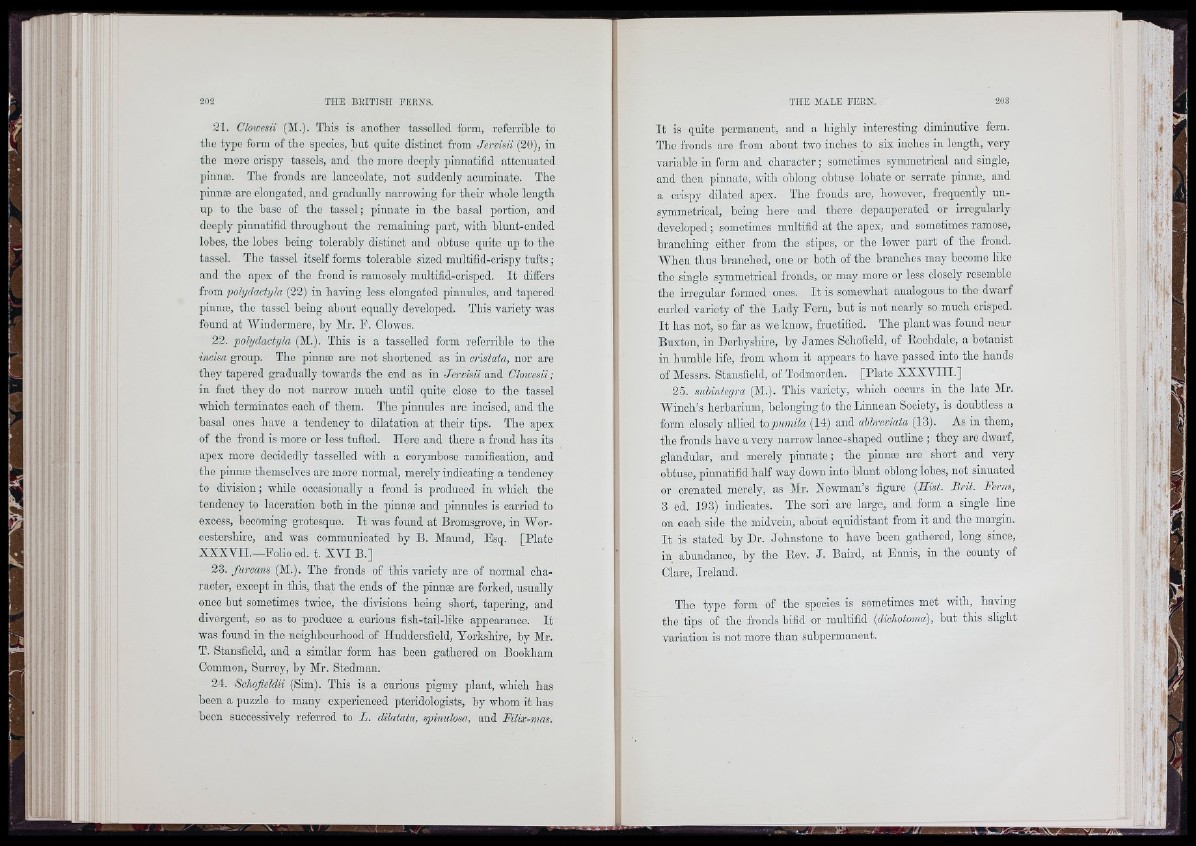
21. Clowesii (M.). This is another tassollod form, referrible to
tho typo form of tho species, but quite distinct from Jervisii (20), in
tho more crispy tassels, and tho more deeply pinnatifid attenuated
piimæ. The fronds are lanceolate, not suddenly acuminate. The
pinnæ are elongated, and gradually narrowing for thoir whole length
up to the base of the tassel ; pinnate in the basal portion, and
deeply pinnatifid throughout the remaining part, with blunt-endod
lobes, the lobes hoing tolerably distmot and obtuse quite up to the
tassel. Tho tassel itself forms tolerable sized multifid-orispy tufts ;
and the apox of the frond is ramosely multifid-orisped. I t differs
from pohjdacUjIa (22) in having loss elongated pinnules, and tapered
pinnæ, tho tassel boing about equally developed. This variety was
found at lYindermere, by Mr. F. Clowes.
22. polydactyla (M.). This is a tasselled form roforrible to the
incisa group. The pinnæ aro not shortened as in cristata, nor are
they tapered gradually towards the end as in Jervisii and Glmvesii;
in fact they do not narrow much until quite close to the tassel
which terminates each of them. Tho pinnules aro incised, and the
basal ones have a tondcnoy to dilatation at their tips. The apex
of the frond is more or loss tufted. Here and there a frond has its
apex more decidedly tasselled with a corymbose ramification, and
tho pinnæ themselves are more normal, merely indicating a tendency
to division ; while occasionally a frond is produced in which the
tendency to laceration both in the piunæ and pinnules is carried to
excess, heooming grotesque. I t was found at Bromsgrove, in lYor-
cestershire, and was communicated hy B. Maund, Esq. [Plate
XXXYII.—Folio ed. t. XVI B.]
23. fuream (M.). The fronds of this variety are of normal oharaoter,
except in this, th a t the ends of the pinnæ are forked, usually
once but sometimes twice, the divisions being short, tapering, and
divergent, so as to produce a curious fish-tail-like appearance. I t
was found in the neighbourhood of Huddersfield, Yorkshire, hy Mr.
T. Stansfiold, and a similar form has been gathered on Bookham
Common, Surrey, hy Mr. Stedman.
24. Schofleldii (Sim). This is a curious pigmy plant, which has
been a puzzle to many experienced pteridologists, hy whom it has
boon successively referred to L . dilatata, spinulosa, and Filix-mas.
I t is quite permanent, and a highly interesting diminutive fern.
Tho fronds are from about two inches to six inches in length, very
variable in form and character ; sometimes symmetrical and single,
and then pinnate, with oblong obtuso lobate or serrate pinnæ, and
a crispy dilated apex. Tho fronds arc, however, frequently uii-
symmotrical, being here and there depauperated or irregularly
developed ; sometimes multifid at the apox, and sometimes ramose,
branching oithor from the stipes, or the lower part of the frond.
IVhen thus branched, one or both of tho hranohos may become like
the single symmetrical fronds, or may more or less closely resemble
the irregular formed ones. I t is somoAvhat analogous to the dwarf
curled variety of the Lady Fern, but is not nearly so much crisped.
I t has not, so far as we know, fructified. The plant was found near
Buxton, in Derbyshire, hy James Schofield, of Rochdale, a botanist
in humble life, from whom it appears to havo passed into the hands
of Messrs. Stansfiold, of Todmorden. [Plato X XX VIII.]
25. suhintegra (M.). This variety, rvhich occurs in the late Mr.
Winch’s herbarium, belonging to the Linnean Society, is doubtless a
form closely allied iopumila (14) and abbreviata (13). As in them,
the fronds have a very narrow lanee-shapod outline ; they are dwarf,
glandular, and merely pinnate; the pinnæ are short and very
obtuse, pinnatifid half way doAvn into blunt oblong lobes, not sinuated
or orenated merely, as Mr. Newman’s figure (liist. Brit. Ferns,
3 ed. 193) indicates. The sori are large, and form a single line
on each side the midvein, about equidistant from it and the margin.
I t is stated by Dr. Johnstone to have been gathered, long since,
in abundance, by the Eev. J. Baird, at Ennis, in the county of
Claro, Ireland.
The type form of the species is sometimes met with, having
the tips of the fronds bifid or multifid (dichotoma), but this slight
variation is not more than suhpermanent.
f
it
i
Î]
■iifi
.1,